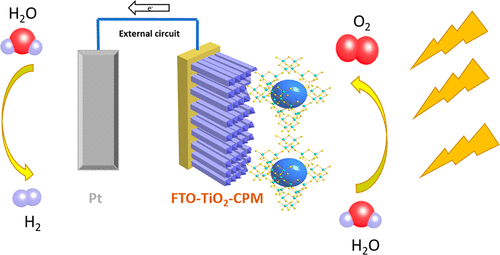Our official English website, www.x-mol.net, welcomes your
feedback! (Note: you will need to create a separate account there.)
Integrating Zeolite-Type Chalcogenide with Titanium Dioxide Nanowires for Enhanced Photoelectrochemical Activity
Langmuir ( IF 3.7 ) Pub Date : 2017-11-15 00:00:00 , DOI: 10.1021/acs.langmuir.7b02403 Chengyu Mao 1, 2 , Yanxiang Wang 2 , Wei Jiao 2, 3 , Xitong Chen 2 , Qipu Lin 2 , Mingli Deng 3 , Yun Ling 3 , Yaming Zhou 3 , Xianhui Bu 4 , Pingyun Feng 1, 2
Langmuir ( IF 3.7 ) Pub Date : 2017-11-15 00:00:00 , DOI: 10.1021/acs.langmuir.7b02403 Chengyu Mao 1, 2 , Yanxiang Wang 2 , Wei Jiao 2, 3 , Xitong Chen 2 , Qipu Lin 2 , Mingli Deng 3 , Yun Ling 3 , Yaming Zhou 3 , Xianhui Bu 4 , Pingyun Feng 1, 2
Affiliation

|
Developing photoanodes with efficient visible-light harvesting and excellent charge separation still remains a key challenge in photoelectrochemical water splitting. Here zeolite-type chalcogenide CPM-121 is integrated with TiO2 nanowires to form a heterostructured photoanode, in which crystalline CPM-121 particles serve as a visible light absorber and TiO2 nanowires serve as an electron conductor. Owing to the small band gap of chalcogenides, the hybrid electrode demonstrates obvious absorption in visible-light range. Electrochemical impedance spectroscopy (EIS) shows that electron transport in the hybrid electrode has been significantly facilitated due to the heterojunction formation. A >3-fold increase in photocurrent is observed on the hybrid electrode under visible-light illumination when it is used as a photoanode in a neutral electrolyte without sacrificial agents. This study opens up a new avenue to explore the potential applications of crystalline porous chalcogenide materials for solar-energy conversion in photoelectrochemistry.
中文翻译:

沸石型硫族化物与二氧化钛纳米线的集成以增强光电化学活性
用有效的可见光收集和出色的电荷分离来开发光阳极仍然是光电化学水分解中的关键挑战。此处,沸石型硫属化物CPM-121与TiO 2纳米线结合在一起形成异质结构的光电阳极,其中晶体CPM-121颗粒用作可见光吸收剂,而TiO 2纳米线充当电子导体。由于硫族化物的带隙小,混合电极在可见光范围内显示出明显的吸收。电化学阻抗谱(EIS)表明,由于异质结的形成,大大促进了混合电极中的电子传输。当在无牺牲剂的中性电解质中将其用作光阳极时,在可见光照射下,在混合电极上观察到光电流增加> 3倍。这项研究开辟了一条新途径,以探索晶体多孔硫族化物材料在光电化学中用于太阳能转换的潜在应用。
更新日期:2017-11-15
中文翻译:

沸石型硫族化物与二氧化钛纳米线的集成以增强光电化学活性
用有效的可见光收集和出色的电荷分离来开发光阳极仍然是光电化学水分解中的关键挑战。此处,沸石型硫属化物CPM-121与TiO 2纳米线结合在一起形成异质结构的光电阳极,其中晶体CPM-121颗粒用作可见光吸收剂,而TiO 2纳米线充当电子导体。由于硫族化物的带隙小,混合电极在可见光范围内显示出明显的吸收。电化学阻抗谱(EIS)表明,由于异质结的形成,大大促进了混合电极中的电子传输。当在无牺牲剂的中性电解质中将其用作光阳极时,在可见光照射下,在混合电极上观察到光电流增加> 3倍。这项研究开辟了一条新途径,以探索晶体多孔硫族化物材料在光电化学中用于太阳能转换的潜在应用。











































 京公网安备 11010802027423号
京公网安备 11010802027423号